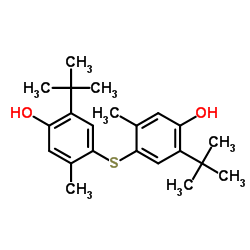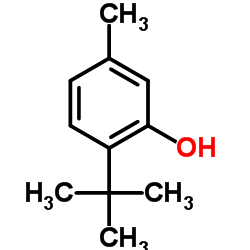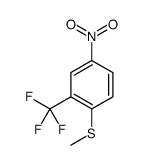96-69-5
| Name | 4,4'-Thiobis(6-tert-butyl-m-cresol) |
|---|---|
| Synonyms |
yoshinoxs
nocrac300 4,4-Thiobis(6-t-butyl-m-cresol) USAF B-15 santonoxbm 5-tert-butyl-4-hydroxy-2-methylphenylsulfide Rutenol 4,4-Thiob 4,4'-Sulfanediylbis[5-methyl-2-(2-methyl-2-propanyl)phenol] MFCD00026287 Santonox nonflexbps Thanox300 4,4'-Sulfanediylbis(2-tert-butyl-5-methylphenol) EINECS 202-525-2 |
| Density | 1.1±0.1 g/cm3 |
|---|---|
| Boiling Point | 475.6±45.0 °C at 760 mmHg |
| Melting Point | 160-165 °C |
| Molecular Formula | C22H30O2S |
| Molecular Weight | 358.537 |
| Flash Point | 230.7±27.4 °C |
| Exact Mass | 358.196655 |
| PSA | 65.76000 |
| LogP | 7.63 |
| Vapour Pressure | 0.0±1.2 mmHg at 25°C |
| Index of Refraction | 1.595 |
| Water Solubility | <0.01 g/100 mL at 18 ºC |
Synonym:m-Cresol, 4,4'-thiobis(6-tert-butyl-; Bis(3-tert-butyl-4-hydroxy-6-methylphenyl)sulfide; Bis(4-hydroxy-5-tert-butyl-2-methylphenyl) sulfide; Phenol, 4,4'-thiobis(2-(1,1-dimethylethyl)-5-methyl-; 4,4'-Thiobis(6-tert-butyl-m-cresol); 4,4 Section 2 - COMPOSITION, INFORMATION ON INGREDIENTS
Risk Phrases: 36/37/38 Section 3 - HAZARDS IDENTIFICATION EMERGENCY OVERVIEW
Irritating to eyes, respiratory system and skin.The toxicological properties of this material have not been fully investigated. Potential Health Effects Eye: Causes eye irritation. Skin: Causes skin irritation. Ingestion: May cause gastrointestinal irritation with nausea, vomiting and diarrhea. The toxicological properties of this substance have not been fully investigated. Inhalation: Causes respiratory tract irritation. The toxicological properties of this substance have not been fully investigated. Chronic: Chronic exposure may cause liver damage. Section 4 - FIRST AID MEASURES Eyes: Immediately flush eyes with plenty of water for at least 15 minutes, occasionally lifting the upper and lower eyelids. If irritation develops, get medical aid. Skin: Immediately flush skin with plenty of water for at least 15 minutes while removing contaminated clothing and shoes. Get medical aid if irritation develops or persists. Wash clothing before reuse. Ingestion: Do not induce vomiting. If victim is conscious and alert, give 2-4 cupfuls of milk or water. Never give anything by mouth to an unconscious person. Get medical aid. Inhalation: Remove from exposure and move to fresh air immediately. If not breathing, give artificial respiration. If breathing is difficult, give oxygen. Get medical aid if cough or other symptoms appear. Notes to Physician: Treat symptomatically and supportively. Section 5 - FIRE FIGHTING MEASURES General Information: As in any fire, wear a self-contained breathing apparatus in pressure-demand, MSHA/NIOSH (approved or equivalent), and full protective gear. During a fire, irritating and highly toxic gases may be generated by thermal decomposition or combustion. This material in sufficient quantity and reduced particle size is capable of creating a dust explosion. Extinguishing Media: Use extinguishing media most appropriate for the surrounding fire. Use dry chemical, CO2, or halogenated agents. Section 6 - ACCIDENTAL RELEASE MEASURES General Information: Use proper personal protective equipment as indicated in Section 8. Spills/Leaks: Vacuum or sweep up material and place into a suitable disposal container. Reduce airborne dust and prevent scattering by moistening with water. Clean up spills immediately, observing precautions in the Protective Equipment section. Avoid generating dusty conditions. Remove all sources of ignition. Provide ventilation. Section 7 - HANDLING and STORAGE Handling: Remove contaminated clothing and wash before reuse. Minimize dust generation and accumulation. Avoid breathing dust, vapor, mist, or gas. Avoid contact with eyes, skin, and clothing. Keep container tightly closed. Avoid ingestion and inhalation. Use with adequate ventilation. Storage: Do not store in direct sunlight. Store in a tightly closed container. Store in a cool, dry, well-ventilated area away from incompatible substances. Section 8 - EXPOSURE CONTROLS, PERSONAL PROTECTION Engineering Controls: Facilities storing or utilizing this material should be equipped with an eyewash facility and a safety shower. Use adequate ventilation to keep airborne concentrations low. Exposure Limits CAS# 96-69-5: United Kingdom, WEL - TWA: 10 mg/m3 TWA United Kingdom, WEL - STEL: 20 mg/m3 STEL United States OSHA: 15 mg/m3 TWA (total dust); 5 mg/m3 TWA (respirable fraction) Belgium - TWA: 10 mg/m3 VLE France - VME: 10 mg/m3 VME Malaysia: 10 mg/m3 TWA Netherlands: 10 mg/m3 MAC Spain: 10 mg/m3 VLA-ED Personal Protective Equipment Eyes: Wear appropriate protective eyeglasses or chemical safety goggles as described by OSHA's eye and face protection regulations in 29 CFR 1910.133 or European Standard EN166. Skin: Wear appropriate protective gloves to prevent skin exposure. Clothing: Wear appropriate protective clothing to prevent skin exposure. Respirators: A respiratory protection program that meets OSHA's 29 CFR 1910.134 and ANSI Z88.2 requirements or European Standard EN 149 must be followed whenever workplace conditions warrant respirator use. Section 9 - PHYSICAL AND CHEMICAL PROPERTIES Physical State: Powder Color: light gray - tan Odor: slight aromatic odor pH: Not available. Vapor Pressure: 0.00000063 mm Hg @ 70C Viscosity: Not available. Boiling Point: Not available. Freezing/Melting Point: 161 - 164 deg C Autoignition Temperature: Not applicable. Flash Point: 215 deg C ( 419.00 deg F) Explosion Limits, lower: Not available. Explosion Limits, upper: Not available. Decomposition Temperature: Solubility in water: insoluble Specific Gravity/Density: 1.10 @ 25C Molecular Formula: C22H30O2S Molecular Weight: 358.54 Section 10 - STABILITY AND REACTIVITY Chemical Stability: Stable under normal temperatures and pressures. Conditions to Avoid: Incompatible materials, dust generation, excess heat. Incompatibilities with Other Materials: Strong oxidizing agents. Hazardous Decomposition Products: Carbon monoxide, oxides of sulfur, irritating and toxic fumes and gases, carbon dioxide. Hazardous Polymerization: Has not been reported Section 11 - TOXICOLOGICAL INFORMATION RTECS#: CAS# 96-69-5: GP3150000 LD50/LC50: CAS# 96-69-5: Oral, rabbit: LD50 = 3200 mg/kg; Oral, rat: LD50 = 2345 mg/kg. Carcinogenicity: 5-tert.-Butyl-4-hydroxy-2-methylphenyl sulfide - Not listed by ACGIH, IARC, or NTP. Other: See actual entry in RTECS for complete information. Section 12 - ECOLOGICAL INFORMATION Section 13 - DISPOSAL CONSIDERATIONS Dispose of in a manner consistent with federal, state, and local regulations. Section 14 - TRANSPORT INFORMATION IATA Not regulated as a hazardous material. IMO Not regulated as a hazardous material. RID/ADR Not regulated as a hazardous material. Section 15 - REGULATORY INFORMATION European/International Regulations European Labeling in Accordance with EC Directives Hazard Symbols: XI Risk Phrases: R 36/37/38 Irritating to eyes, respiratory system and skin. Safety Phrases: S 24/25 Avoid contact with skin and eyes. WGK (Water Danger/Protection) CAS# 96-69-5: 1 Canada CAS# 96-69-5 is listed on Canada's DSL List. CAS# 96-69-5 is listed on Canada's Ingredient Disclosure List. US FEDERAL TSCA CAS# 96-69-5 is listed on the TSCA inventory. SECTION 16 - ADDITIONAL INFORMATION N/A |
CHEMICAL IDENTIFICATION
HEALTH HAZARD DATAACUTE TOXICITY DATA
|
| Hazard Codes | Xi:Irritant; |
|---|---|
| Risk Phrases | R36/37/38 |
| Safety Phrases | S37/39-S26 |
| RTECS | GP3150000 |
| HS Code | 29309070 |
|
~% 
96-69-5 |
| Literature: Journal of the American Chemical Society, , vol. 81, p. 3608 |
| Precursor 1 | |
|---|---|
| DownStream 1 | |
| HS Code | 2930909090 |
|---|---|
| Summary | 2930909090. other organo-sulphur compounds. VAT:17.0%. Tax rebate rate:13.0%. . MFN tariff:6.5%. General tariff:30.0% |


